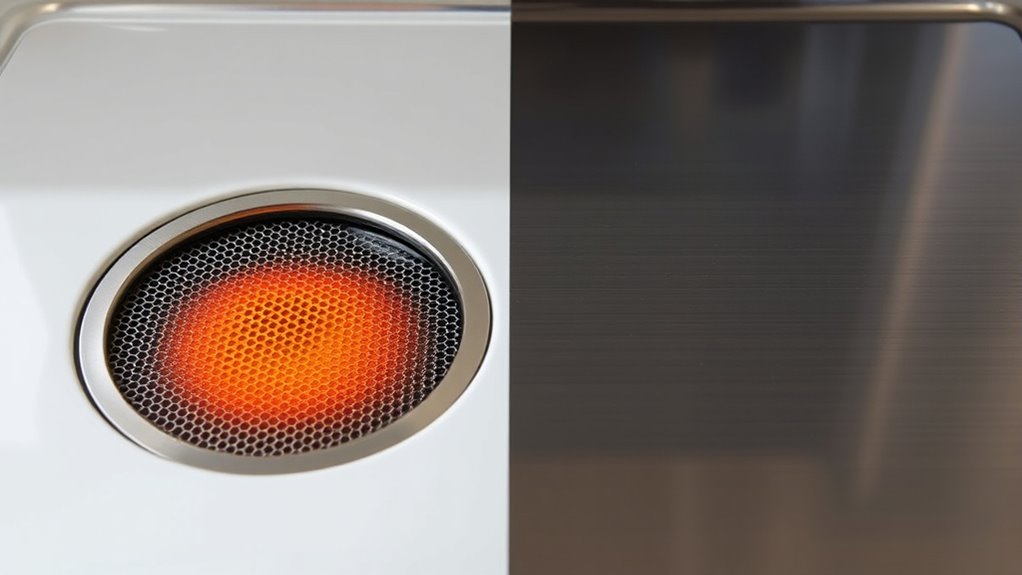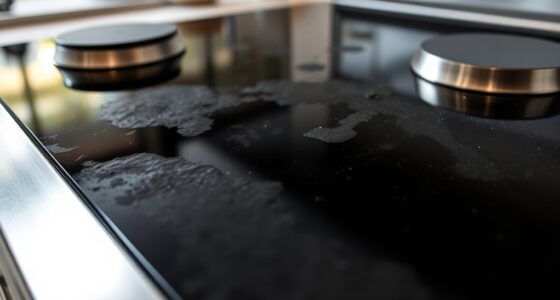Catalytic stoves use a special catalyst to promote cleaner, more complete fuel combustion, resulting in longer burn times and lower emissions. Noncatalytic stoves rely on high temperatures and insulation to achieve efficient burning without any catalyst. They tend to be simpler to operate and maintain, often costing less upfront and over time. To learn more about how these differences affect your choice, consider the details behind their operation and maintenance.
Key Takeaways
- Catalytic stoves use a catalyst to promote cleaner and more efficient combustion, while noncatalytic stoves rely on high temperatures and insulation.
- Catalytic models often require regular catalyst inspection and replacement, whereas noncatalytic stoves need frequent ash and soot cleaning.
- Noncatalytic stoves are typically simpler to operate and maintain, with lower initial and ongoing costs.
- Catalytic stoves tend to burn longer and produce cleaner emissions due to the catalyst’s action.
- Overall, noncatalytic stoves are more affordable and easier to maintain, while catalytic stoves offer higher efficiency and cleaner burn performance.

Are you wondering how catalytic and noncatalytic stoves differ? The main difference lies in how catalytic and noncatalytic stoves differ? The main difference lies in how they burn fuel and handle emissions, which directly impacts their operation, maintenance, and efficiency. When choosing between the two, understanding their ignition methods and maintenance requirements can help you make an informed decision.
Catalytic stoves use a special catalyst—usually made of ceramic or metal—that facilitates a chemical reaction at lower temperatures. This reaction helps burn off gases and smoke more completely, making the stove more efficient and eco-friendly. To ignite a catalytic stove, you typically need to follow specific ignition methods, often involving lighting the fire manually with kindling or using an automatic igniter if the system is equipped. Once lit, maintaining the catalyst is vital; it can get clogged or coated with soot over time, which reduces its effectiveness. Regular maintenance involves inspecting and cleaning the catalyst, replacing it if it becomes damaged, and ensuring the stove’s combustion chamber stays clean. This ongoing upkeep can be a bit more involved compared to noncatalytic models, but it pays off with longer burn times and cleaner emissions. Additionally, catalytic stoves often require proper insulation, which helps maintain high efficiency and optimize heat retention within the stove chamber.
Noncatalytic stoves, on the other hand, don’t rely on a catalyst to burn fuel efficiently. Instead, they use insulation and a design that encourages high temperatures within the combustion chamber. This allows the stove to burn more completely without the need for a catalyst. Ignition methods for noncatalytic stoves are generally straightforward; you start a fire with kindling or lighter fluid, just like in traditional fireplaces. Because they don’t have a catalyst to worry about, their maintenance requirements are usually simpler. You’ll need to regularly remove ash and soot, check the seals and gaskets for wear, and ensure proper airflow to keep the combustion process essential. The lack of a catalyst means less component replacement over time, which can make noncatalytic stoves easier to maintain overall. Moreover, noncatalytic models tend to be more cost-effective over their lifespan due to lower maintenance needs and fewer replacement parts.
Frequently Asked Questions
Can Catalytic Stoves Operate Without Electricity?
Catalytic stoves generally don’t need electricity to operate, as they rely on a catalytic converter to burn smoke and gases efficiently. However, some models depend on electricity for fans or controls, which could limit operation if power goes out. This electricity dependency can create operational limitations, especially during outages. So, while basic catalytics can work without power, additional features might hinder their full functionality without electricity.
How Long Do Catalytic Converters Last?
Your catalytic converter typically lasts around 5 to 10 years, depending on usage and maintenance. To guarantee a longer converter lifespan, you should perform regular maintenance, like cleaning or inspecting it for damage. Neglecting maintenance can shorten its life and reduce stove efficiency. Keep an eye on performance and schedule routine check-ups. Proper care and timely servicing help your catalytic converter last longer, providing ideal safety and efficiency for your stove.
Are Noncatalytic Stoves More Environmentally Friendly?
Think of noncatalytic stoves as straightforward road trips—less complex but still eco-friendly. They generally produce fewer emissions initially but lack the emission reduction benefits catalytic stoves offer through their built-in converters. When it comes to eco friendliness comparison, catalytic stoves often help reduce pollutants more effectively over time. So, if you’re aiming for a greener option, a catalytic stove might be your best bet for long-term environmental benefits.
What Maintenance Is Required for Catalytic Stoves?
You need to regularly inspect and clean the catalytic stove’s components. Check the ignition system to guarantee it sparks properly, and clean or replace it if necessary. Also, remove ash buildup from the catalytic converter and surrounding areas to maintain efficiency. Avoid using harsh chemicals, and follow the manufacturer’s guidelines for maintenance intervals. Proper upkeep keeps your catalytic stove running smoothly and extends its lifespan.
Which Stove Type Is Safer for Indoor Air Quality?
You might find that catalytic stoves are generally safer for indoor air quality because they produce fewer emissions and burn fuel more completely. For example, a homeowner reported improved indoor air and fewer safety concerns after switching to a catalytic stove. While both types require proper venting, catalytic stoves tend to emit fewer harmful particles, making them a better choice if indoor air safety is your priority.
Conclusion
Think of catalytic and noncatalytic stoves as two travelers on a journey. One relies on a map (catalytic), guiding the way with efficiency and purpose, while the other forges ahead with instinct and raw power (noncatalytic). Both reach their destination, but their paths differ in nuance and experience. Choosing between them is like selecting your adventure—each offers a unique route, shaping your cozy home’s warmth with its own story and character.











